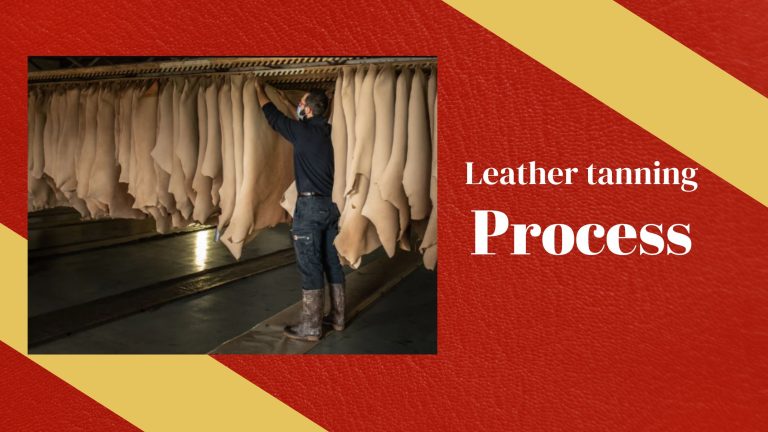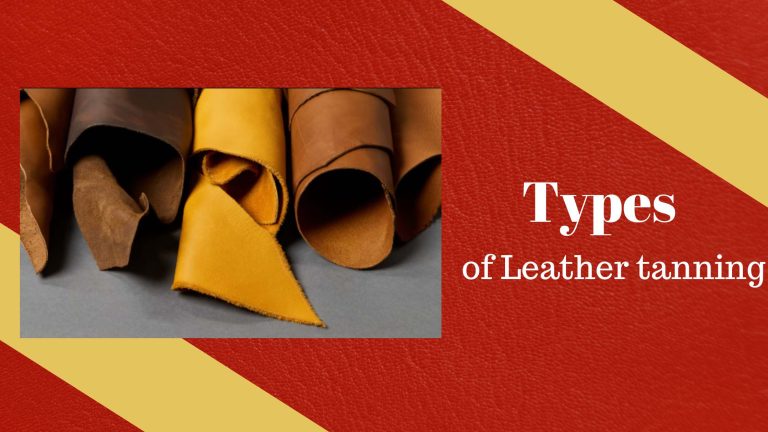Leather is a versatile material and is popular in different industries like fashion, automobiles, and furniture due to its durable characteristics and luxurious appearance. It has unique properties, which makes it a highly sought-after material across various fields.
In this blog, you will explore leather tanning and its types, the benefits and drawbacks of each type of leather tanning, and how you can choose the right tanning method based on the different parameters.
We will also discuss the future of leather tanning, i.e., the emerging trends and technologies in the leather industry.
So, read this blog till the end, as you will learn many things about leather tanning and processing.
What is Leather Tanning?
In leather tanning, raw hides or skins are treated with tannins or other chemicals to stabilize the collagen protein, which prevents decomposition and makes the material more resistant to environmental factors such as water, heat, and microorganisms. This tanning process provides properties like softness, strength, and durability to the leather items.

Process of Leather Tanning
The selected hides and skin move through many processes before they become ready to be used by various industries.
Preparation:
Raw hides are first cleaned and soaked to remove any flesh, fat, and hair. This process often includes liming. It helps to loosen hair and other residues, which makes the hide easier to process.
Pickling:
The hides are then soaked in an acidic solution, usually containing salt and sulfuric acid, to prepare them for tanning. This step adjusts the pH level and improves the penetration of tanning agents.
Tanning:
Leather tanning is the core of the process, where hides are treated with tannins (natural or synthetic), chrome salts, or other chemical agents. Tannins can be plant-based (vegetable tanning) or synthetic (such as chromium salts in chrome tanning). This step stabilizes the collagen fibers in the hide, which makes it resistant to decay and more flexible.
Post-Tanning Processes:
After tanning is done, the leather undergoes additional treatments to enhance its appearance and functionality. These can include dyeing, conditioning, and finishing to achieve desired colors, textures, and protective properties.

Importance of Tanning in Leather Production
The tanning process embeds different characteristics in the leather, which makes it the most demanding raw material in several industries. Let’s see why tanning is important in leather production:
Durability:
Tanning makes leather resistant to decomposition. Without tanning, raw hides would quickly deteriorate due to bacterial and fungal action. The tanning process stabilizes the collagen fibers, ensuring that the leather remains strong and flexible over time.
Flexibility and Texture:
Tanning transforms stiff and brittle raw hides into supple and pliable leather. This flexibility makes leather a useful material in a variety of applications and industries.
Water Resistance:
Properly tanned leather can resist water penetration, which is important for many applications like footwear and outdoor gear. This resistance helps maintain the leather’s integrity and appearance under various conditions.
Aesthetic Qualities:
Tanning processes also affect the appearance of the leather, like its color, grain, and sheen. Different tanning methods and post-tanning treatments can produce a wide range of finishes, from matte to glossy, and can be dyed in numerous colors.
Longevity:
Tanning extends the lifespan of leather products by preventing the hide from decaying and enhancing its strength. This makes leather a durable choice for high-wear items such as furniture, car interiors, and accessories.

Types of Leather Tanning: Their Benefits and Drawbacks
Leather tanning is not just limited to one type; it can be tanned in many types. Let’s discuss each of them one by one:
A. Vegetable Tanning:
Vegetable tanning uses natural tannins extracted from plant sources like oak, chestnut, and hemlock. The process involves soaking hides in a solution of these tannins, which binds to the collagen fibers and stabilizes them.
Benefits:
- Eco-Friendly: Vegetable tanning relies on natural materials and does not involve harsh chemicals, making it more environmentally friendly.
- Unique Patina: The leather develops a distinct patina over time, enhancing its character and appearance.
- Biodegradable: Leather tanned with vegetable tannins is generally biodegradable and less harmful to the environment when discarded.
Drawbacks:
- Time-Consuming: The process can take several weeks to complete, which can be a drawback for industries needing quicker turnaround times.
- Less Resistant to Water and Heat: Vegetable-tanned leather can be less water-resistant and heat-resistant compared to other methods, making it less suitable for some applications.
- Higher Cost: Due to the time involved and the use of natural materials, vegetable-tanned leather can be more expensive.
B. Chrome Tanning:
Chrome tanning utilizes chromium salts, primarily chromium (III) sulfate, in a quicker process to transform raw hides into leather. The method is popular for its efficiency and the quality of leather produced.
Benefits:
- Quick Process: Chrome tanning is much faster than vegetable tanning, typically taking just a few days.
- Soft and Flexible: Leather produced through chrome tanning is generally softer and more flexible, making it ideal for garments and upholstery.
- Water-Resistant: Chrome-tanned leather is more resistant to water and heat, which enhances its durability and practicality.
Drawbacks:
- Environmental Concerns: The process generates chromium waste, which can be harmful if not properly managed. This waste can contribute to soil and water pollution.
- Health Risks: Chromium compounds, particularly in higher concentrations, can pose health risks to workers and consumers.
- Less Biodegradable: Chrome-tanned leather is less biodegradable than vegetable-tanned leather, raising concerns about long-term environmental impact.
C. Chrome-Free Tanning:
Chrome-free tanning refers to methods that avoid chromium salts, using alternative agents such as synthetic chemicals or natural tannins. This category includes processes like aldehyde tanning and synthetic polymer tanning.
Benefits:
- Reduced Environmental Impact: Many chrome-free methods aim to minimize environmental damage by avoiding chromium and using more sustainable agents.
- Sustainability: Chrome-free tanning often incorporates more sustainable practices and materials, aligning with eco-friendly goals.
Drawbacks:
- Quality Variability: The quality of leather can be less consistent, as different agents and methods can produce varying results.
- Higher Cost: Some chrome-free methods may be more expensive due to the use of specialized chemicals or the need for additional processing.
- Limited Availability: Chrome-free tanning techniques are not as widely used as chrome tanning, which can limit options for consumers and manufacturers.
Choosing the Right Tanning Method
When selecting a tanning method, several factors should be considered:
1. End Use:
The intended application of the leather will guide the choice. For items requiring high flexibility and water resistance, such as clothing and footwear, chrome tanning might be preferred. For products where eco-friendliness and a unique appearance are important, such as luxury accessories or artisanal goods, vegetable or chrome-free tanning could be more suitable.
2. Budget:
The cost of tanning can vary significantly. Vegetable tanning is often more expensive due to its lengthy process and use of natural materials. Chrome tanning, while faster and generally more affordable, involves higher environmental and health-related costs. Chrome-free tanning might have higher initial costs but can offer long-term benefits in terms of sustainability.
3. Environmental Impact:
Consider the environmental implications of each method. Vegetable tanning is typically the most eco-friendly, whereas chrome tanning can have substantial environmental and health concerns. Chrome-free options offer a middle ground, potentially reducing some negative impacts but varying in effectiveness and cost.
4. Production Time:
If time is a critical factor, chrome tanning’s faster processing may be essential. Conversely, if you can afford longer production times for the sake of environmental benefits or specific aesthetic qualities, vegetable or chrome-free tanning might be preferable.

Future of Leather Tanning
Innovations in Tanning Technologies:
Ultra-High Definition Graphics on Leather:
Advances in digital printing technology allow manufacturers to apply ultra-high-definition graphics directly onto leather surfaces. This technique lets them create detailed and vibrant designs, enhancing personalization and customization for leather products. The benefits include unique aesthetics and brand differentiation, though challenges involve ensuring graphic durability and addressing the environmental impact of inks and printing processes.
Water-Efficient Innovations:
The leather industry adopts water-efficient technologies to address the high water usage of traditional tanning processes. Innovations such as waterless tanning techniques, advanced recycling systems, and closed-loop water management significantly reduce water consumption and wastewater production. These advancements help conserve water resources and minimize environmental impact, though they may require costly infrastructure changes and ongoing research to ensure effectiveness.
Emerging Trends:
Sustainable and Eco-Friendly Tanning Methods:
The industry shifts toward sustainable tanning methods by developing plant-based and bio-based tanning agents and exploring alternatives like mushroom leather. These innovations aim to reduce environmental impact by using renewable resources and minimizing harmful chemicals. While these methods align with growing consumer demand for eco-friendly products, they face challenges such as higher costs, scalability issues, and the need for industry-wide adoption.
Circular Economy and Recycling:
The leather industry embraces a circular economy by recycling leather scraps and by-products into new products and designing items for easier recycling or upcycling. This approach reduces waste and resource consumption while extending the lifecycle of leather goods. Implementing these practices requires significant changes in industry practices, consumer education, and infrastructure to address potential issues with the quality and value of recycled materials.
The Bottom Line
The choice of leather tanning method significantly impacts the quality and sustainability of leather items. Different techniques—such as vegetable, chrome, and chrome-free tanning—affect the durability, flexibility, and environmental footprint of leather. This decision influences how manufacturers utilize leather and the overall efficiency of leather processing. Selecting the right tanning method helps manufacturers enhance product performance and address environmental and economic concerns, ensuring that the leather meets both practical and ethical standards.
